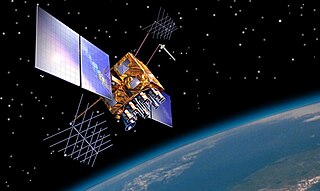Autonomous Space Transport Robotic Operations (ASTRO), is an American technology demonstration satellite which was operated as part of the Orbital Express program. It was used to demonstrate autonomous servicing and refuelling operations in orbit, performing tests on the NEXTSat satellite which was launched with ASTRO for that purpose. Launched in March 2007, it was operated for four months, and then deactivated in orbit.
NEXTSat, or Next Generation Satellite and Commodities Spacecraft (NEXTSat/CSC) is an American technology demonstration satellite which was operated as part of the Orbital Express programme. It was used as a target spacecraft for a demonstration of autonomous servicing and refueling operations performed by the ASTRO satellite. Launched in March 2007, it was operated for four months, and then deactivated in orbit.

Advanced Extremely High Frequency (AEHF) is a constellation of communications satellites operated by the United States Space Force. They are used to relay secure communications for the United States Armed Forces, the British Armed Forces, the Canadian Armed Forces, the Netherlands Armed Forces and the Australian Defence Force. The system consists of six satellites in geostationary orbits. The final satellite was launched on 26 March 2020. AEHF is backward compatible with, and replaces, the older Milstar system and will operate at 44 GHz uplink and 20 GHz downlink. The AEHF system is a joint service communications system that provides survivable, global, secure, protected, and jam-resistant communications for high-priority military ground, sea and air assets.

USA-200, also known as NRO Launch 28 or NROL-28, is an American signals intelligence satellite, operated by the National Reconnaissance Office. Launched in 2008, it has been identified as the second satellite in a series known as Improved Trumpet, Advanced Trumpet, or Trumpet follow-on; a replacement for the earlier Trumpet series of satellites.

USA-214, also known as Advanced Extremely High Frequency-1 or AEHF-1, is a military communications satellite operated by the United States Air Force. It is the first of six satellites to be launched as part of the Advanced Extremely High Frequency program, which will replace the earlier Milstar system.
USA-215, also known as NRO Launch 41 or NROL-41, is an American reconnaissance satellite, operated by the National Reconnaissance Office (NRO). Launched in 2010, it has been identified as the first in a new series of imaging radar satellites, developed as part of the Future Imagery Architecture (FIA) programme, to replace the earlier Lacrosse spacecraft.

USA-203, also known as GPS IIR-20(M), GPS IIRM-7 and GPS SVN-49, is an American navigation satellite which was intended to become part of the Global Positioning System. It was the sixth of seven Block IIRM satellites to be launched, and the twentieth of twenty one Block IIR satellites overall. It was built by Lockheed Martin, using the AS-4000 satellite bus, and had a mass of 2,032 kilograms (4,480 lb).

USA-232, also known as GPS IIF-2, and GPS SVN-63, is an American navigation satellite which forms part of the Global Positioning System. It was the second of twelve Block IIF satellites to be launched.

USA-239, also known as GPS IIF-3, GPS SVN-65, and Navstar-67 is an American navigation satellite which forms part of the Global Positioning System. It was the third of twelve Block IIF satellites to be launched.

USA-248, also known as GPS IIF-5, GPS SVN-64 and NAVSTAR 69, is an American navigation satellite which forms part of the Global Positioning System. It was the fifth of twelve Block IIF satellites to be launched.

USA-251, also known as GPS IIF-6, GPS SVN-67 and NAVSTAR 70, is an American navigation satellite which forms part of the Global Positioning System. It was the sixth of twelve Block IIF satellites to be launched.

USA-256, also known as GPS IIF-7, GPS SVN-68 and NAVSTAR 71, is an American navigation satellite which forms part of the Global Positioning System. It was the seventh of twelve Block IIF satellites to be launched.

USA-258, also known as GPS IIF-8, GPS SVN-69 and NAVSTAR 72, is an American navigation satellite which forms part of the Global Positioning System. It was the eighth of twelve Block IIF satellites to be launched.

USA-262, also known as GPS IIF-10, GPS SVN-72 and NAVSTAR 74, is an American navigation satellite which forms part of the Global Positioning System. It was the tenth of twelve Block IIF satellites to be launched.

USA-265, also known as GPS IIF-11, GPS SVN-73 and NAVSTAR 75, is an American navigation satellite which forms part of the Global Positioning System. It was the eleventh of twelve Block IIF satellites to be launched.

USA-289, also known as GPS-III SV01 or Vespucci, is a United States navigation satellite which forms part of the Global Positioning System. It was the first GPS Block III satellite to be launched.

USA-235, also known as Advanced Extremely High Frequency 2 or AEHF-2, is a military communications satellite operated by the United States Air Force. It is the second of six satellite to be launched as part of the Advanced Extremely High Frequency program, which replaced the earlier Milstar system.

USA-246, also known as Advanced Extremely High Frequency 3 or AEHF-3, is a military communications satellite operated by the United States Air Force. It is the third of six satellites to be launched as part of the Advanced Extremely High Frequency program, which replaced the earlier Milstar system.

USA-292, also known as Advanced Extremely High Frequency 5 or AEHF-5, is a military communications satellite operated by the United States Space Force. It is the fifth of six satellites to be launched as part of the Advanced Extremely High Frequency program, which replaced the earlier Milstar system.

USA-298, also known as Advanced Extremely High Frequency 6 or AEHF-6, is a military communications satellite operated by the United States Space Force (USSF). It is the sixth of six satellite to be launched as part of the Advanced Extremely High Frequency program, which replaced the earlier Milstar system.






